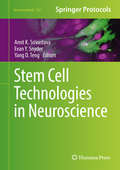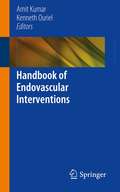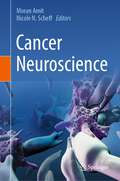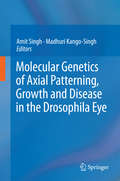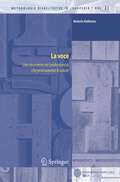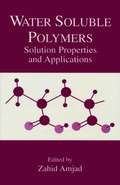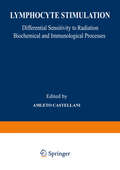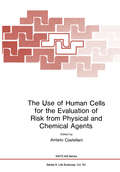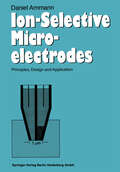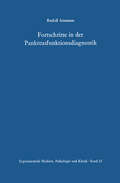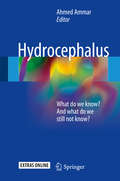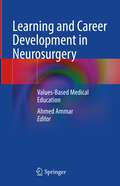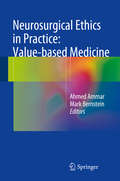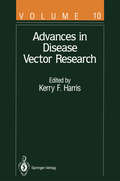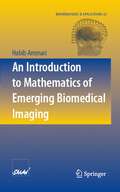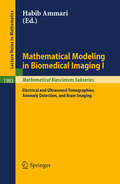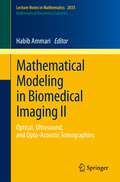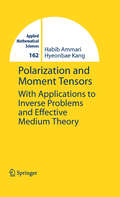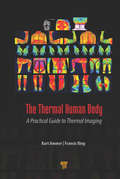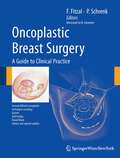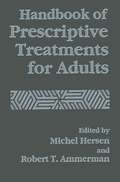- Table View
- List View
Stem Cell Technologies in Neuroscience (Neuromethods #126)
by Amit K. Srivastava, Evan Y. Snyder and Yang D. TengThis volume provides comprehensive knowledge on the fundamental techniques and detailed laboratory protocols used in stem cell research and their potential application in the field of neuroscience. The chapters in this book cover detailed descriptions of techniques for isolation, maintenance, differentiation, and characterization of neural stem cells, and the development of in vitro stem cell-based neurological disease model. There are detailed methods on leading techniques for stem cell genetic engineering and intra-organ transplantation for research and therapeutic purposes, in vivo imaging of donor stem cells, and essential requirements for setting up a new stem cell laboratory. Neuromethods series offers chapters with key advice and procedure specifics to empower the readers to successfully achieve their own scientific and experimental goals. Cutting-edge and pragmatic, Stem Cell Technologies in Neuroscience is a valuable resource for academic and translational researchers, industry scientists, biology teachers, and life science graduate students to grasp the vital pulse of the rapidly growing field of stem cell research.
Handbook of Endovascular Interventions
by Amit Kumar and Kenneth OurielHandbook of Endovascular Interventions presents a step-wise approach to the techniques of peripheral vascular interventions. Covering interventions in all major organ systems, this concise and comprehensive resource provides the rationale on why these approaches have been adopted by most practicing vascular interventionalists. This volume also presents key information on intervention techniques and pitfalls, complications and their management, surgical management options, as well as landmark papers on the topic. Unique to this book is the inclusion of sections building an endovascular suite, and coding as well as international training paradigms across the globe.Authored by international experts from around the globe, Handbook of Endovascular Interventions is a true how-to book for the busy interventionalist.
Cancer Neuroscience
by Moran Amit Nicole N. ScheffThis volume is the first on the market to address and discuss the emerging field of cancer neuroscience. Edited by pioneers in the field with contributions from top researchers, the volume serves as a comprehensive overview of the role of nerves in tumorigenesis and cancer progression. Chapters will address how the innervation of tumors can serve as both prognostic and predictive biomarkers as well as actionable therapeutic targets. Authors will describe current research efforts, and future directions for study and translation to the clinic. It is becoming increasingly apparent that certain treatments will need to consider interactions between the nervous system and cancer, and the novel concepts presented in the book address related accumulating evidence regarding therapeutic strategies. This unique volume will be useful for cancer researchers, neuroscientists, cancer biologists, oncologists, and others looking to gain a greater understanding of this emerging field.
Molecular Genetics of Axial Patterning, Growth and Disease in the Drosophila Eye
by Amit Singh and Madhuri Kango-SinghUndoubtedly, Drosophila melanogaster, fruit fly, has proved to be one of the most popular invertebrate model organisms, and the work horse for modern day biologists. Drosophila, a highly versatile model with a genetic legacy of more than a century, provides powerful genetic, cellular, biochemical and molecular biology tools to address many questions extending from basic biology to human diseases. One of the most important questions in biology focuses on how does a multi-cellular organism develop from a single-celled embryo. The discovery of the genes responsible for pattern formation has helped refine this question, and led to other questions, such as the role of various genetics and cell biological pathways in regulating the crucial process of pattern formation and growth during organogenesis. Drosophila eye model has been extensively used to study molecular genetic mechanisms involved in patterning and growth. Since the genetic machinery involved in the Drosophila eye is similar to humans, it has been used to model human diseases and homology to eyes in other taxa. This book will discuss molecular genetic mechanisms of pattern formation, mutations in axial patterning, Genetic regulation of growth in Drosophila eye, and more. There have been no titles in the past ten years covering this topic, thus an update is urgently needed.
La voce: Uno strumento dei professionisti che promuovono la salute (Metodologie Riabilitative in Logopedia #21)
by Antonio AmitranoL'opera offre una panoramica multidisciplinare sulla voce. Racchiude contributi che discipline diverse hanno dato allo studio della voce: strumento essenziale di ogni relazione e di quella d'aituo in particolare.
Water Soluble Polymers: Solution Properties and Applications
by Zahid AmjadThis volume contains a series of papers originally presented at the symposium on Water Soluble Polymers: Solution Properties and Applications, sponsored by the Division of Colloids and Surface Chemistry of the American Chemical Society. The symposium took place in Las Vegas City, Nevada on 9 to 11th September, 1997 at the 214th American Chemical Society National Meeting. Recognized experts in their - spective fields were invited to speak. There was a strong attendance from academia, g- ernment, and industrial research centers. The purpose of the symposium was to present and discuss recent developments in the solution properties of water soluble polymers and their applications in aqueous systems. Water soluble polymers find applications in a number of fields of which the following may be worth mentioning: cosmetics, detergent, oral care, industrial water treatment, g- thermal, wastewater treatment, water purification and reuse, pulp and paper production, sugar refining, and many more. Moreover, water soluble polymers play vital role in the oil industry, especially in enhanced oil recovery. Water soluble polymers are also used in ag- culture and controlled release pharmaceutical applications. Therefore, a fundamental kno- edge of solution properties of these polymers is essential for most industrial scientists. An understanding of the basic phenomena involved in the application of these polymers, such as adsorption and interaction with different substrates (i. e. , tooth enamel, hair, reverse - mosis membrane, heat exchanger surfaces, etc. ) is of vital importance in developing high performance formulations for achieving optimum efficiency of the system.
Reizen en ziekte
by A.M.L. Gompel G.J.B. SonderSteeds meer mensen maken verre reizen. De enorme toename van het internationaal reizen confronteert de huisarts met een groeiende vraag naar advies over vaccinatie en chemoprofylaxe bij het vertrek, en met de diagnostiek van een mogelijk exotische aandoening bij terugkeer. In Reizen en ziekte wordt uitvoerig op deze ontwikkeling ingespeeld. Reizen en ziekte is uit vijf delen opgebouwd. In deel 1 komen algemene onderwerpen aan bod waaronder reizigersconsult en keuring. Deel 2 geeft een overzicht van onderwerpen die van belang zijn voor de vertrekkende reiziger. Op reis gaan met specifieke gezondheidsproblemen of gezondheidsrisico's komt in het derde deel aan bod. Het vierde deel behandelt klachten van de thuiskomende reiziger, zoals diarree, zweten, worminfecties, en deel vijf behandelt de medische problemen bij migranten en adoptiekinderen.
Lymphocyte Stimulation: Differential Sensitivity to Radiation Biochemical and Immunological Processes
by AmletoCastellaniThis book is a collection of some of the papers presented at the EMBO Lecture Course on "Lymphocyte stimulation: differential sensitivity to radiation; biochemical and immunological properties." The Course was organized with the aim of fostering interactions between photoradiobiologists and immunologists interested in the problem of DNA damage and repair studied at the lymphocyte level. The papers presented in this book are mainly centered on the problem of radiation sensitivity of lymphocytes in relation to DNA repair phenomena. The radiation biology of human lymphocytes is dominated by two phenomena: (a) high radiosensitivity of lymphocytes which die in interphase (b) PHA-induced relative radioresistance of those cells which, after stimulation, escape the interphase death and eventually die in mitosis. These phenomena constitute a good system to study some of the factors which control the response of human cells to irradiation. In addition it is possible to correlate the development of the relative radioresistance in PHA-stimulated lymphocytes with the biochemical changes connected with the transformation processes. The papers presented in this book constitute a real contribution to the scientific knowledge in this field of research and suggest that lymphocytes could be a very interesting test material useful for measuring the DNA repair capability of human cells to furnish an indication of individual radiosensitivity in man.
The Use of Human Cells for the Evaluation of Risk from Physical and Chemical Agents
by AmletoCastellaniIn this volume are collected 30 papers, 9 round table discus sions and 11 communications presented at the ASI Course on "The use of human cells for the evaluation of risk from physical and chemical agents", sponsored by NATO and organized by ENEA. The aim of the Course was to present different scientific ap proaches and technical advices in order to get dose-effect relation ships which are the basis for risk evaluation. The scientific back ground which is behind this approach was extensively discussed. Emphasis has been given to the use of human cells or human data in order to attempt to have a correct and realistic evaluation of the damage in humans. There are many criticisms on the use of animal data for human risk evaluation because of differences between species and between strains within the same species: differences in metabolism, activa tion processes and DNA repair ability makes uncertain the extrapola tion of animal data to humans. Also data obtained using specific strains or highly inbred strains in order to reduce the variance are not applicable due to the heterogeneity of the human population connected with individual responses. In this respect only the use of human cells enable us to detect the individual variability and to identify sensitive subpopu lations that would be at greater risk. My appreciation to Pieranita and Alberto Castellani for the as sistance during the meeting and to Giuseppe Biondi for his help in some of the editorial work.
Ion-Selective Microelectrodes: Principles, Design and Application (Advances In Experimental Medicine And Biology Ser. #50)
by Daniel AmmannFortschritte in der Pankreasfunktionsdiagnostik: Beitrag zum Problem der Diagnose von subakut-chronischen Pankreasaffektionen unter spezieller Berücksichtigung der Stuhlenzymmethode und des Pankreozymin-Secretintests (Experimentelle Medizin, Pathologie und Klinik #22)
by R. AmmannHydrocephalus: What do we know? And what do we still not know?
by Ahmed AmmarThis book provides the reader with a well-structured, comprehensive approach to hydrocephalus and related syndromes. It also addresses the ethical dilemmas of managing hydrocephalus, of which many neurosurgeons are unaware, and presents cutting-edge research genetic and pathophysiology research on hydrocephalus. The book presents a new classification for the Dandy Walker syndrome, based on a new understanding of different hydrocephalic problems. Further, it puts forward a wholly new theory on the pathophysiology and development of multiloculated hydrocephalus. This book helps the reader to devise a long-term strategic plan to treat patients, based on research of favorable long-term outcomes of hydrocephalus. It uniquely provides evidence-based approaches to managing hydrocephalus, presenting the experience and thoughts of renowned and highly experienced neurosurgeons from the USA, Canada, Japan, Europe and the Middle East.
Learning and Career Development in Neurosurgery: Values-Based Medical Education
by Ahmed AmmarThe neurosurgical, surgical and medical training and practice models have to keep up with the technological revolution in the 21st Century as our lives changed on a swift base. Making bioethics and metacognition a cornerstone in medical education and practice will flourish our humane societies. Metacognition is thinking about one’s thinking, to plan, monitor and assess one’s understanding and performance. By adherence to medical ethics and Values-Based Medicine (VsBM) as guiding principles, we can develop benevolent medical practice. To enhance knowledge application, skills, and character qualities in realms beyond the immediate context in which they were learned. In this book, we developed a framework on how to evolve medical education and training by utilizing hi-tech. We divided the book into five principal components; Current and traditional root analysis of the learning process, Ethics and metacognition of education, learning and career development, Obstacles, difficulties and setbacks in learning and career development process, Learning in the digital era, and Mentorship. The author believes we are entering a new era of information technology, which will have a significant impact on the education, sciences, strategies and philosophy. Therefore, in preparation for this colossal transformation, the author brings together the best brains in the neurosurgical field from around the globe. Twenty distinguished Professors of Neurosurgery and educators from Canada, the USA, Colombia, the UK, Italy, the Netherland, India, Japan, China, Rwanda, Egypt and Saudi Arabia gathered their experiences and thoughts in this book to shade light on an evolving world that will be the norm in near future.
Neurosurgical Ethics in Practice: Value-based Medicine
by Ahmed Ammar Mark BernsteinGood neurosurgical practice is based not only on evidence, skills, and modern equipment, but also on good values. This book is the first to discuss specifically the ethical issues that arise during the daily practice of neurosurgery. It is divided into three parts addressing patients’ rights, ethical issues relating to the working environment, and wider societal aspects such as dealings of neurosurgeons with the legal system, the media, and companies. The authors are well-established neurosurgeons who present the ethical problems that they have encountered during their careers and explain what they have learned in confronting these problems. In all, more than 50 neurosurgical cases drawn from real life are reported and discussed from an ethical point of view. This book will be especially informative for young neurosurgeons and will provide all who work in this very special field with a road map on how to avoid violations of medical ethics in neurosurgical practice.
Advances in Disease Vector Research (Advances in Disease Vector Research #10)
by El Desouky Ammar Y. Antignus T. R. Burkot E. P. Camargo Y. Chinzei S. Cohen D. Gonsalves P. M. Graves H. H. Hagedorn R. Hull E. I. Korenberg Yu. V. Kovalevskii G.W. Otim-Nape M. K. Shaw A. J. Shelley W. J. Tabachnick DeMar Taylor J. M. Thresh F. G. Wallace S. D. Yeh A. S. YoungVolume 10 of Advances in Disease Vector Research consists of seven chapters on vectors that affect human or animal health and six chapters on plant pathogens and their vectors. In Chapter 1, Yasuo Chinzei and DeMar Taylor discuss hormonal regulation of vitellogenesis in ticks. Many blood sucking insects and ticks transmit pathogens by engorgement, which induces vitellogenesis and oviposition in adult animals. To investigate the pathogen transmission mechanism in vector animals, information on the host physiological and endocrinological conditions after engorgement is useful and important because pathogen development or proliferation occurs in the vector hosts at the same time as the host reproduction. Chinzei and Taylor have shown that in ticks, juvenile hormone (JH) is not involved in the endocrinological processes inducing vitellogenin biosynthesis. Synganglion (tick brain) factor(s) (vitellogenesis inducing factor, VIF) is more important to initiate vitellogenesis after engorgement, and ecdysteroids are also related to induction of vitellogenin synthesis. In their chapter, based mainly on their own experimental data, the authors discuss the characterization of main yolk protein, vitellogenin (Vg) , biosynthesis and processing in the fat body, and hormonal regulation of Vg synthesis in tick systems, including ixodid and argasid ticks.
An Introduction to Mathematics of Emerging Biomedical Imaging (Mathématiques et Applications #62)
by Habib AmmariBiomedical imaging is a fascinating research area to applied mathematicians. Challenging imaging problems arise and they often trigger the investigation of fundamental problems in various branches of mathematics. This is the first book to highlight the most recent mathematical developments in emerging biomedical imaging techniques. The main focus is on emerging multi-physics and multi-scales imaging approaches. For such promising techniques, it provides the basic mathematical concepts and tools for image reconstruction. Further improvements in these exciting imaging techniques require continued research in the mathematical sciences, a field that has contributed greatly to biomedical imaging and will continue to do so. The volume is suitable for a graduate-level course in applied mathematics and helps prepare the reader for a deeper understanding of research areas in biomedical imaging.
Mathematical Modeling in Biomedical Imaging I: Electrical and Ultrasound Tomographies, Anomaly Detection, and Brain Imaging (Lecture Notes in Mathematics #1983)
by Habib AmmariMathematical Modeling in Biomedical Imaging II: Optical, Ultrasound, and Opto-Acoustic Tomographies (Lecture Notes in Mathematics #2035)
by Habib AmmariThis volume reports on recent mathematical and computational advances in optical, ultrasound, and opto-acoustic tomographies. It outlines the state-of-the-art and future directions in these fields and provides readers with the most recently developed mathematical and computational tools. It is particularly suitable for researchers and graduate students in applied mathematics and biomedical engineering.
Polarization and Moment Tensors: With Applications to Inverse Problems and Effective Medium Theory (Applied Mathematical Sciences #162)
by Habib Ammari Hyeonbae KangThis book presents important recent developments in mathematical and computational methods used in impedance imaging and the theory of composite materials. By augmenting the theory with interesting practical examples and numerical illustrations, the exposition brings simplicity to the advanced material. An introductory chapter covers the necessary basics. An extensive bibliography and open problems at the end of each chapter enhance the text.
The Thermal Human Body: A Practical Guide to Thermal Imaging
by Kurt Ammer Francis RingThis book is a guide for the constantly growing community of the users of medical thermal imaging. It describes where and how an infrared equipment can be used in a strictly standardised way and how one can ultimately comprehensively report the findings. Due to their insight into the complex mechanisms behind the distribution of surface temperature, future users of medical thermal imaging should be able to provide careful, and cautious, interpretations of infrared thermograms, thus avoiding the pitfalls of the past. The authors are well-known pioneers of the technique of infrared imaging in medicine who have combined strict standard-based evaluation of medical thermal images with their expertise in clinical medicine and related fields of health management.
The Thermal Human Body: A Practical Guide to Thermal Imaging
by Kurt Ammer Francis RingThis book is a guide for the constantly growing community of the users of medical thermal imaging. It describes where and how an infrared equipment can be used in a strictly standardised way and how one can ultimately comprehensively report the findings. Due to their insight into the complex mechanisms behind the distribution of surface temperature, future users of medical thermal imaging should be able to provide careful, and cautious, interpretations of infrared thermograms, thus avoiding the pitfalls of the past. The authors are well-known pioneers of the technique of infrared imaging in medicine who have combined strict standard-based evaluation of medical thermal images with their expertise in clinical medicine and related fields of health management.
Oncoplastic Breast Surgery: A Guide to Clinical Practice
by Bernard AmmererThe initial idea to write a book on oncoplastic techniques was raised through a meeting on breast cancer treatment in Saalfelden, A- tria two years ago. Contrary to the rather minor role breast surgery is conceded today compared to other treatment modalities the s- geons role on the further outcome of the disease is crucial and never compensated by radiation or adjuvant therapy. Whereas surgery a decade ago was merely excision of the cancer and closure of the wound leaving behind a mutilated breast in many women, the advent of oncoplastic surgery completely changed the modern surgical approach to breast cancer. The concept of oncoplastic breast surgery combines oncologic - mor resection - either breast conservation or mastectomy - with t- ditional or less traditional plastic surgical techniques. The primary goal is to achieve an optimal cosmetic result with long time local tumor control. Some (non – randomized) studies available in patients following breast conservation oncoplastic surgery showed tumor resection to be associated with wider free margins, less patients needing re-operation surgery for involved or close margins, a widening of the indications for breast conser- tion surgery, a low complication rate and at least an equal local recurrence rate. There is no doubt that oncoplastic breast surgery experienced a r- id rise with more patients demanding this kind of surgery. However, a profound knowledge of the different oncoplastic techniques is - sential for the outcome.
Handbook of Aggressive and Destructive Behavior in Psychiatric Patients
by Robert Ammerman Michel Hersen L. A. SissonScarcely a day passes without the media detailing some form of human aggression, whether it be on its grandest scale in the form of war, random bombings and shootings in the streets, torture in a prison camp, murder by gangs, wife abuse resulting in the murder of the husband, or the physical abuse of children, sometimes resulting in their death. Frequently perpetrators of human aggression, when arrested and tried in court, resort to a psychiatric defense. But are all such aggressors indeed appropriately psychiatric patients? And if so, what are their particular diagnoses and how do these relate to aggression? Also of concern is aggression directed against self, as evidenced in the rising incidence of suicide among young people or the self-mutilation of patients suffering from certain personality disorders. Both violence directed outward and aggression toward oneself pose considerable challenges to clinical management, whether in the therapist's office or in the inpatient unit. Although we have not been able to find successful deterrents to aggression, a sizeable body of evidence does exist, certainly of a descriptive nature. Such data for psychiatric patients are scattered, however, and can be found in literatures as diverse as the biological, ethological, epidemiological, legal, philosophical, psychological, psychiatric, and crimi nological. Therefore, given the increased frequency with which mental health professionals encounter cases of violence in their day-to-day work, we believed it important that existing data be adduced in one comprehensive volume.
Case Studies in Family Violence
by Robert T. AmmermanThe past 20 years have seen the emergence of family violence as one of the most critical problems facing society. The alarming incidence figures of abuse and neglect directed toward family members justify this atten tion. For example, over 1 million children are thought to be abused and neglected each year. Similarly, almost 2 million women are victims of wife battering each year. Annual rates of elderly mistreatment are thought to be as high as 32 per 1000 population. Accurate epidemiologi cal data only now are being compiled on more recently recognized forms of mistreatment, such as psychological abuse, ritualistic abuse of chil dren, and child witnessing of adult violence. The pervasiveness of do mestic mistreatment makes it a priority for clinicians and researchers alike. For clinicians, intrafamilial violence represents a formidable chal lenge with respect to assessment and treatment. The etiology of abuse and neglect is multidetermined. There are numerous pathways in the development of family violence, and these interact and converge in a nonlinear fashion. The consequences of family violence are equally com plex and divergent. Victims of mistreatment can display a variety of physical injuries and psychological disturbances. No single psychiatric syndrome or symptom constellation has been consistently implicated in any form of family mistreatment. The perpetrators of family violence are equally heterogeneous in their clinical presentations. Illustrative dys functions in perpetrators include skill deficits, substance abuse, mental illness, and impulse-control disorders.
Handbook of Prescriptive Treatments for Adults
by Robert T. Ammerman Michel HersenThis book could not have been conceptualized or published 20 years ago. Indeed, it is doubtful that we could have organized the material for this handbook 10 years ago. Over the last 20 years, however, the painstaking efforts of many clinical researchers working with a variety of resistive psychopathologies have resulted in specific psychotherapies and pharmacotherapies that are effective with a significant propor tion of patients, at least for some of the disorders. Much clinical research remains to be carried out in the forthcoming decades. But now that we are nearing the 21st century, at least some statement about efficacy can be made. In 1967, Gordon Paul succinctly stated that the ultimate goal of treatment outcome research is to determine "What treatment, by whom, is most effective for this individual with that specific problem, and under which set of circumstances" (p. 111). At that time, empirical evaluations of psychosocial and pharmacologic treatments were few and far between. Methodological strategies for determining treatment effectiveness were also in the formative stage, as exemplified by introduc tion of control groups that received inactive interventions (i. e. , placebo) and the relatively recent practice of comparing two or more treatments in addition to placebo. In the almost three decades since Paul's oft-quoted dictum, both the quantity and the quality of treatment outcome research with adults have increased dramati cally.
